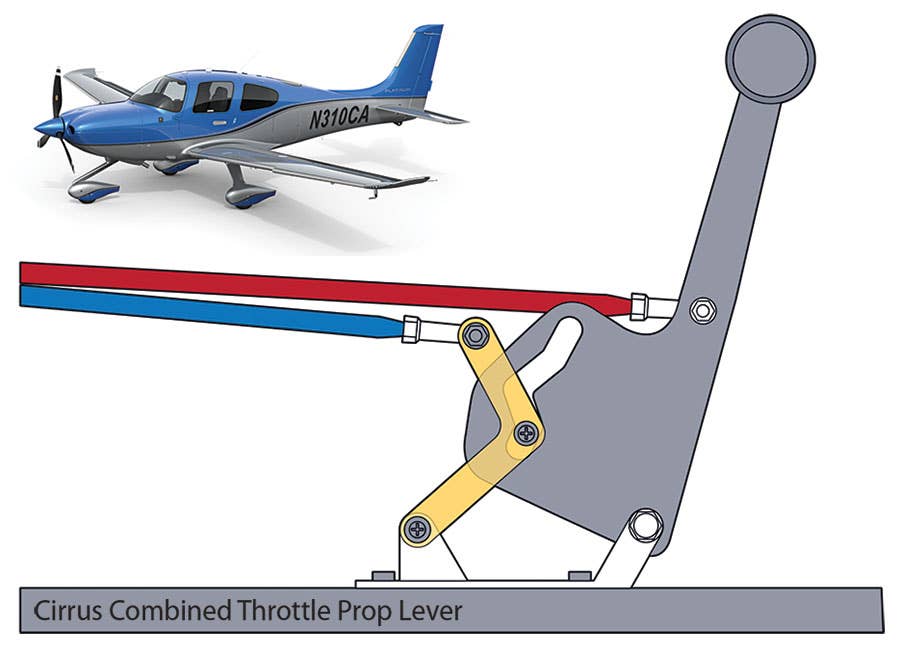

There’s something to be said for simplicity when teaching people to fly or merely checking out in a new aircraft. Simplicity was Cirrus’ motivation behind this month’s feature, the combined throttle and propeller control that’s standard on both the Cirrus SR20 and SR22.
In complex aircraft, a throttle controls engine acceleration, while a separate blue propeller lever adjusts the pitch of the propeller through a propeller governor. Together, they create a given power setting, and that’s how, in the Cirrus, the old throttle control came to be known as a power lever.
On their first glance into the cockpit of a Cirrus, some pilots might think the single black leather-wrapped handle on the throttle quadrant is connected to a turbine engine because there’s no blue propeller control knob nearby. The mixture control next to the engine control is the only real giveaway that under the hood sits either a 215 hp Lycoming or a 315 hp Continental reciprocating power plant.
Operating an aircraft equipped with a variable-pitch propeller, also known as a constant-speed prop, requires training in order not to mismanage the use of the throttle and propeller controls. Combining the throttle and the propeller control into a single power lever not only eliminates the need for a separate propeller control, but it also reduces pilot workload while helping protect the engine from damage that might be caused by an inadequately trained pilot. Some pilots have expressed disdain for the Cirrus combined system, believing it offers no control over engine rotations per minute. The propeller is actually controllable, just over a narrower rpm range.
On Cirrus aircraft, the power lever is connected to a mechanical cam also attached to a pair of cables running from the throttle quadrant and out the firewall. One cable is connected to the engine throttle, the other to the propeller governor. By using a machined slot in the cam, the system mechanically moves the propeller control as the throttle control is moved fore and aft. The cams are slightly different for the various models because travel distance, required rpm changes and other factors vary. Only the SR22 Turbo does not have a cable-controlled governor, meaning the propeller is fixed at 2,500 rpm.
The propeller governor senses engine speed using flyweights and the throttle setting through a cable connected to the power control lever. Moving the power lever forward causes the governor to meter less high-pressure oil to the propeller hub, allowing centrifugal force acting on the blades to flatten the propeller pitch for higher-rpm operation. Reducing the power-lever demand causes the governor to meter more high-pressure oil to the propeller hub, forcing the blades to an increased pitch or reduced-rpm position. During cruise flight, the governor again adjusts the propeller to maintain an rpm setting. Any change in airspeed or load on the propeller results in a change in propeller pitch.
While power settings vary some, depending upon the Cirrus model, full throttle on takeoff should produce about 29 inches of manifold pressure while spinning the propeller at 2,700 rpm. As the pilot retards the throttle and depending upon the position of the cam, the prop begins to automatically slow, but will not drop below 2,500 at high-power settings. The behavior of the prop governor at reduced power is, however, exactly the same as with a conventional prop control set at 2,500. Once manifold pressure drops low enough that the propeller can’t maintain 2,500, the rpm will, of course, begin to decline. On the Cirrus, as power is increased from idle to maximum, the pilot will feel a slight bump through the handle as the power lever moves past the three-quarter point. This confirms the propeller has begun to move above the 2,500 rpm stop.

Sign-up for newsletters & special offers!
Get the latest FLYING stories & special offers delivered directly to your inbox






